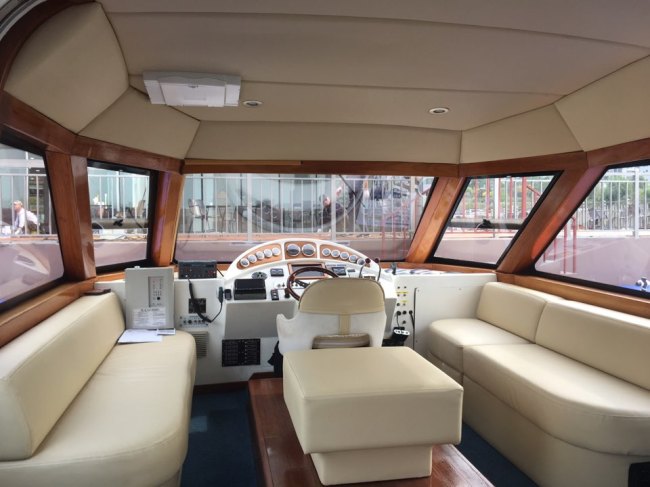Three days before the Han River water taxi service resumed last month, a group of reporters boarded one at the dock located inside Banpo Han River Park in Seoul.
Eight water taxis were anchored at the water taxi stand, while workers were busy putting the finishing touches to the boulevard that led to the dock.
“We will get to your destination as soon as possible in the safest way,” said Kim In-geun, a water taxi driver with 30 years of experience at sea, welcoming passengers with a friendly smile.
 |
A Han River water taxi is anchored at taxi stand inside Banpo Han River park. (Kim Da-sol/The Korea Herald) |
The interior of the boat was luxurious and the seats were soft. Apart from a few bumps, the ride was surprisingly comfortable.
It took about eight minutes for the water taxi to depart “Seoraenaru” ferry dock at Banpo Han River Park and arrive at Yeouido.
“Unless Han River freezes during winter, water taxis will be able to provide a quick and safe ride for commuters,” Kim proudly said.
 |
(Kim Da-sol/The Korea Herald) |
Akin to a chauffeur-driven limousine on the road, the water taxis were first introduced in Seoul in 2007. After years of slow business, with an average number of seven daily passengers, the service came to halt in April 2014, when it was revealed that the service’s operator was Cheonghaejin Marine Co., a shipping company linked to the sinking of the Sewol ferry.
Resuming the operation after a 2 1/2 year hiatus with a new operator, the Seoul Metropolitan Government has also changed the target customer group.
Of the eight water taxes in service, five will be mainly used by tourists for sightseeing, offering onboard programs such as feeding migratory birds and watching the sunset.
The rest -- three taxis that can fit up to seven passengers -- will shuttle commuters.
Traveling at a speed of 60 kilometers per hour, a water taxi can get from Jamsil to Yeouido in 40 minutes. A single trip costs 5,000 won ($4.35) -- 20 minutes faster and 13,000 won cheaper than a road taxi.
“We are going to provide season tickets or T-money service for commuters in order to provide convenience to passengers and actively promote the water taxi as a form of transportation,” said Kim Jung-ho, the manager of Han River water taxi operation in Seoul City.
Despite the ambitious plans, hurdles seem to remain for the business to take off.
“Water taxis may be faster on the water, but it takes at least 15 minutes to walk from the water taxi stand to my office located at Jamsil Station. I think I would rather take the subway, despite it being super packed in the morning, since I would not have to walk so much,” a 34-year-old office worker who commutes to Jamsil every morning told The Korea Herald.
An American lawyer who frequently visits Seoul said she does not see the difference between a water taxi and the ferry cruise that started running on the Han River in July.
“When I visit the Han River, I normally opt for (the) sightseeing ferry because it is cheaper for a longer ride. I think maybe I could try a water taxi once, although the price is twice as much, for private use such as partying,” she said.
The multipurpose cruise ship Araho, a city-run sightseeing ferry cruise on the Han River, has been gaining popularity among citizens and foreigners for its onboard activities such as watching a traditional Samulnori show and buffet dining. Seoul City said the cruise attracted at least a thousand visitors over the summer this year.
Kim, the manager of Han River water taxi operations at Seoul City said that water taxis can cater to a small group of passengers’ needs as it operates eight different sightseeing courses.
According to him, water taxis used for sightseeing will cost 25,000 won per person for the first 30 minutes of each ride, with 8,000 won charged for every additional 10 minutes.
The price is far lower than the previous price of 70,000 won for a 30-minute trip.
On the accessibility issue, Seoul Metropolitan Government said it would install more bicycle stands and run a public bicycle rental service around the water taxi stands so passengers can easily travel to nearby destinations or bus and subway stations.
Environmentalists also take issue with water taxies.
According to the Korean Federation for Environmental Movement, programs on the water taxis could negatively influence the ecosystem of animals that live at the Han River.
“Migratory birds are very sensitive when they visit (floating islets in the Han River) to rest. Programs such as feeding migratory birds on water taxis is an absolutely ridiculous idea,” said Shin Jae-un from the KFEM.
Bamseom, one of the uninhabited islets on the part of the Han River near Yeouido, is frequently visited by migratory birds such as mallards, great egrets, mandarins, common kestrels and spotbills throughout the year.
While it offers no access to humans, Bamseom was officially designated as a habitat for migratory birds in 2012. It has been left as a natural sanctuary for its characteristic Ramsar wetlands. Some experts visit it for bird watching or observation of the unique ecosystem located in the heart of the city.
Environmental activists also argued that the sound or waves that water taxis make could have an impact on animals such as migratory birds.
“Some civic groups are trying to reserve part of the Han River as a habitat for endangered animals such as porpoises,” said an official from the KFEM.
“If Seoul City decides to run water taxis without noticing the effects it has on the ecosystem of the Han River as well as its low economic benefits, it is making the same mistake as a previous mayor did a decade ago,” an official added.
By Kim Da-sol (
ddd@heraldcorp.com)








![[Today’s K-pop] Blackpink’s Jennie, Lisa invited to Coachella as solo acts](http://res.heraldm.com/phpwas/restmb_idxmake.php?idx=644&simg=/content/image/2024/11/21/20241121050099_0.jpg)
